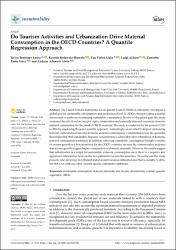Do Tourism Activities and Urbanization Drive Material Consumption in the OECD Countries? A Quantile Regression Approach

View/
Date
2021Author
Lasisi, Taiwo TemitopeEluwole, Kayode Kolawole
Alola, Uju Violet
Aldieri, Luigi
Vinci, Concetto Paolo
Alola, Andrew Adewale
Metadata
Show full item recordAbstract
The United Nations Sustainable Development Goals (UNSDGs) elaborately encompass a
global goal for sustainable consumption and production (Goal 12: SDGs), thus providing potential
drivers and/or pathways to attaining sustainable consumption. In view of this global goal, this study
examined the role of real income per capita, urbanization and especially inbound tourism in domestic
material consumption for the panel of OECD countries. The study is conducted for the period of 1995
to 2016 by employing the panel quantile approach. Interestingly, an inverted U-shaped relationship
between outbound tourism and domestic material consumption is established across the quantiles,
thus indicating that sustainable domestic consumption is achievable after a threshold of domestic
material consumption is attained. In addition, achieving sustainable consumption through economic
or income growth is a herculean task for the OECD countries because the current reality indicates
that income growth triggers higher consumption of domestic materials. However, the results suggest
that urbanization is a recipe for sustainable domestic consumption since there is a negative and
significant relationship between the two parameters across the quantiles. Nevertheless, the study
presents relevant policy for efficient material and resources utilization and that is suitable to drive
the SDGs for 2030 and other country-specific sustainable ambitions.
Volume
13Issue
14Collections
The following license files are associated with this item:

















